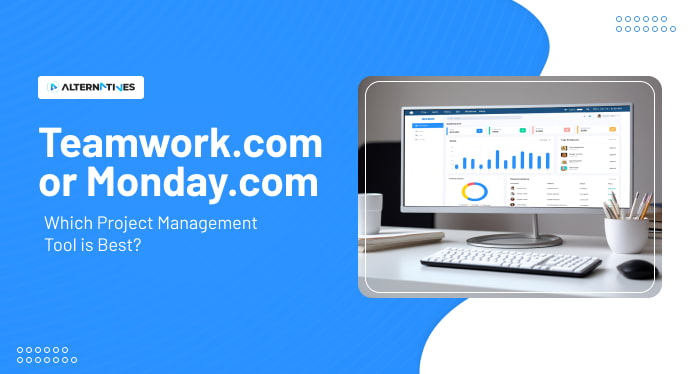Power BI Vs. Qlik Sense: Which One is Best for Your Business?

The world of business intelligence is constantly evolving, and businesses must be able to adapt quickly to take advantage of new opportunities. With the emergence of two powerful solutions for data analysis and visualization, Power BI and Qlik Sense, it can be difficult to determine which is best for your business. In this article, we will compare these two solutions side-by-side to help you make an informed decision about which one is right for your organization.
A Quick Overview of Power BI
Power BI is a powerful business analytics tool by Microsoft, enabling users to visualize and analyze data effortlessly. With intuitive dashboards, interactive reports, and real-time insights, Power BI transforms raw data into actionable intelligence. Its features include data connectivity, customizable visuals, and collaboration tools. For users seeking alternatives, exploring options like Tableau or QlikView is recommended or users can also check out Power BI alternatives.
A Quick Overview of Qlik Sense
Qlik Sense, a leading business intelligence platform, stands out with its interactive dashboards, robust reporting, and predictive analytics. Users benefit from automated report compilation, simplifying data-driven decision-making. Qlik Sense’s intuitive design fosters dynamic insights, making it a top choice for businesses. For those seeking similar tools like Qlik Sense, exploring options like Power BI or Tableau can provide diverse analytics solutions tailored to specific needs or can check out our top curated list of Qlik Sense alternatives.
Features Comparison For Power BI Vs Qlik Sense
| Feature | Power BI | Qlik Sense |
| Reports to Share and Collaborate | Power BI facilitates easy sharing and collaboration through its user-friendly interface. Users can create, share, and collaborate on interactive reports seamlessly. | Qlik Sense excels in collaborative reporting with its associative data model, enabling users to create and share dynamic reports, and fostering collaborative decision-making. |
| Datamarts | Power BI supports the creation and integration of datamarts, allowing users to organize and structure data for efficient analysis. | Qlik Sense seamlessly integrates datamarts, providing a unified view of structured data for comprehensive analysis and decision-making. |
| Real-time Analytics | Power BI offers real-time analytics, allowing users to monitor and analyze data as it updates in real time, providing timely insights. | Qlik Sense excels in real-time analytics, enabling users to make informed decisions with up-to-the-minute data updates and dynamic visualizations. |
| Data Security and Encryption | Power BI prioritizes data security with robust encryption measures, ensuring the confidentiality and integrity of sensitive information. | Qlik Sense places a strong emphasis on data security and encryption, implementing comprehensive measures to safeguard data throughout the analytics process. |
| Data Factory | Power BI integrates seamlessly with Azure Data Factory, facilitating data orchestration and movement for streamlined analytics workflows. | Qlik Sense offers robust data factory capabilities, empowering users to efficiently manage and integrate data from various sources for comprehensive analysis. |
| Data Visualizations | Power BI provides a diverse range of customizable visuals, enabling users to create compelling and insightful data visualizations for effective communication. | Qlik Sense stands out in data visualization, offering a rich library of interactive and dynamic visuals to convey complex insights with clarity. |
| No-code Automation Builder | Power BI features a user-friendly no-code automation builder, allowing users to automate repetitive tasks and processes without the need for extensive coding knowledge. | Qlik Sense empowers users with a no-code automation builder, facilitating the automation of workflows and processes for increased efficiency and productivity. |
| Interactive Dashboards | Power BI’s interactive dashboards offer a seamless user experience, allowing users to explore and interact with data visually for deeper insights. | Qlik Sense excels in interactive dashboards, enabling users to create dynamic, associative dashboards for intuitive exploration and analysis of complex datasets. |
| Embedded Analytics | Power BI supports embedded analytics, allowing users to integrate reports and dashboards directly into applications for a cohesive user experience. | Qlik Sense seamlessly integrates embedded analytics, enabling users to embed analytics directly into applications, enhancing accessibility and usability. |
| Data Lineage Connectors | Power BI offers robust data lineage connectors, providing transparency into the source and transformation of data throughout the analytics process. | Qlik Sense features comprehensive data lineage connectors, offering visibility into the origin and evolution of data, ensuring data quality and reliability. |
| Automated Report Compilation | Power BI streamlines report compilation with automated features, saving time and ensuring consistency in reporting across the organization. | Qlik Sense excels in automated report compilation, empowering users to generate reports automatically, enhancing efficiency and accuracy in data reporting. |
| Mobile App Support | Power BI offers dedicated mobile apps for iOS and Android, ensuring users can access and interact with their data on-the-go for maximum flexibility. | Qlik Sense provides robust mobile app support, allowing users to access and analyze data seamlessly from their mobile devices, ensuring data accessibility anytime, anywhere. |
| Natural Language Interaction | Power BI supports natural language interaction, allowing users to query and analyze data using conversational language for a more intuitive analytics experience. | Qlik Sense excels in natural language interaction, enabling users to interact with data using natural language queries, and fostering a user-friendly and intuitive analytics environment. |
| Pricing | Power BI offers multiple subscription plans which includes a free version for basic use and Power BI Pro, Power BI Premium. | Qlik Sense provides three subscription plans: Standard, Premium, and Enterprise, starting at $20 per user per month. |
| Digital Onboarding | Power BI facilitates digital onboarding with user-friendly tutorials and documentation, ensuring a smooth onboarding process for new users. | Qlik Sense prioritizes digital onboarding, offering intuitive tutorials and documentation to help new users quickly adapt to the platform for a seamless start. |
Power BI Vs Qlik Sense: Feature Comparison
1. Reports to Share and Collaborate
The Reports to Share and Collaborate feature in Power BI and Qlik Sense facilitates seamless collaboration and data-driven decision-making. Power BI offers shared reports with real-time collaboration, enhancing teamwork. Meanwhile, Qlik Sense empowers users with collaborative reporting on shared dashboards, fostering effective decision-making. Both platforms prioritize accessibility, ensuring teams can collaborate effortlessly. Power BI’s emphasis is on real-time collaboration within reports, while Qlik Sense focuses on collaborative decision-making through shared dashboards, providing users flexibility in their collaborative analytics approach.
2. Datamarts
The Datamarts feature in Power BI and Qlik Sense enhances analytical capabilities by enabling the creation of specialized datasets. Power BI seamlessly integrates datamarts, empowering users to craft targeted data sets catering to specific business needs. Qlik Sense equally excels, allowing users to develop data marts for precise analytical requirements. Both platforms prioritize flexibility, providing tools for users to curate datasets tailored to their unique analytics objectives. Whether in Power BI or Qlik Sense, the Datamarts feature supports agile and strategic data management.
3. Real-Time Analytics
The Real-time Analytics feature in Power BI and Qlik Sense elevates data analysis by offering up-to-the-minute insights. Power BI provides users with real-time analytics capabilities, ensuring timely decision-making based on the most current data. Similarly, Qlik Sense excels in real-time analytics, enabling users to access and analyze data in its most current state. Both platforms prioritize delivering insights without delay, empowering users to make informed decisions based on the latest information, and enhancing the agility and responsiveness of their analytical processes.
4. Data Security and Encryption
The Data Security and Encryption features in Power BI and Qlik Sense underscore their commitment to safeguarding sensitive information. Power BI employs robust encryption measures and access controls, ensuring the confidentiality and integrity of data. Likewise, Qlik Sense prioritizes data security through granular access controls and encryption, adhering to compliance standards. Both platforms provide users with comprehensive security measures, instilling confidence in data handling and compliance, essential for maintaining trust and protecting critical business information.
5. Data Factory
Power BI seamlessly integrates with Azure Data Factory, allowing users to orchestrate and automate data workflows for efficient processing. Meanwhile, Qlik Sense supports data factory capabilities, facilitating automation for enhanced data management. Both platforms prioritize data encryption, ensuring secure data handling. Power BI emphasizes Azure’s capabilities, while Qlik Sense focuses on versatile automation, collectively delivering efficient data workflows and robust encryption for comprehensive data management.
6. Data Visualizations
The Data Visualizations feature in Power BI and Qlik Sense empowers users to create compelling and insightful reports. Power BI offers a diverse range of customizable visualizations, allowing users to present data dynamically through various chart options and styles. Similarly, Qlik Sense excels in data visualizations, providing a plethora of customizable charts and graphs for creating engaging visual insights. Both platforms prioritize delivering rich visual experiences, ensuring users can effectively communicate and interpret data for informed decision-making.
7. No-Code Automation Builder
The No-Code Automation Builder feature in Power BI and Qlik Sense empowers users to automate tasks effortlessly. Power BI offers a user-friendly no-code automation builder, enabling seamless automation of processes without requiring extensive coding skills. Similarly, Qlik Sense provides a no-code automation builder, allowing users to automate workflows effortlessly, enhancing overall operational efficiency. Both platforms prioritize accessibility, enabling users to streamline processes and automate routine tasks, ultimately saving time and increasing productivity in data management and analytics.
8. Interactive Dashboards
The Interactive Dashboards feature in Power BI and Qlik Sense revolutionizes data exploration with dynamic insights. Power BI’s dashboards provide users with an engaging and responsive experience, allowing for real-time interaction and analysis. Similarly, Qlik Sense excels in interactive dashboards, empowering users to dynamically explore and interact with data for an intuitive analytics experience. Both platforms prioritize user engagement, fostering a responsive environment where data exploration is not only informative but also user-friendly and tailored to specific analytical needs.
9. Embedded Analytics
The Embedded Analytics feature in Power BI and Qlik Sense seamlessly integrates analytics into external applications, enhancing accessibility. Power BI supports robust embedded analytics, allowing users to integrate reports and dashboards effortlessly into external applications. Similarly, Qlik Sense excels in embedded analytics, providing seamless integration into external applications, and enriching user experiences with actionable insights. Both platforms prioritize extending the reach of analytics, ensuring users can leverage insights within the context of their existing applications for a more cohesive and comprehensive user experience.
10. Data Lineage Connectors
Power BI provides data lineage connectors, offering users insight into the origin and transformation of data for robust governance. Similarly, Qlik Sense prioritizes data lineage, allowing users to trace the origin and transformation of data for improved governance and compliance. Both platforms empower users with visibility into data flows, reinforcing the reliability and integrity of data throughout its lifecycle.
11. Automated Report Compilation
The Automated Report Compilation feature in Power BI and Qlik Sense streamlines report generation, enhancing efficiency and consistency. Power BI automates report compilation, saving time and ensuring uniformity across various data sets. In parallel, Qlik Sense excels in automated report compilation, maintaining efficiency by automating the generation of reports. Both platforms prioritize time-saving solutions, ensuring users can rely on automated processes for consistent and timely report generation, fostering a more efficient and streamlined reporting workflow.
12. Data Governance
The Data Governance feature in Power BI and Qlik Sense underscores their commitment to data integrity and compliance. Power BI prioritizes governance with features like data lineage, access controls, and audit trails, ensuring robust data governance. Similarly, Qlik Sense places a high emphasis on data governance, offering granular access controls and audit trails to maintain data integrity and meet regulatory standards. Both platforms empower users with tools to enforce governance policies, ensuring data reliability and compliance throughout its lifecycle.
13. Natural Language Interaction
The Natural Language Interaction feature in Power BI and Qlik Sense revolutionizes data exploration by enabling users to query and analyze data using everyday language. Power BI excels in a natural language interaction, allowing users to interact with data effortlessly through plain language queries. Similarly, Qlik Sense supports natural language interaction, empowering users with intuitive data exploration through conversational queries. Both platforms prioritize user-friendly interfaces, making data analysis more accessible and intuitive through the power of natural language interaction.
14. Pricing
Coming to Power BI pricing, it offers a free version and paid plans. Power BI Pro, on a per-user basis, facilitates collaboration and sharing, while Power BI Premium caters to organizations with advanced needs the pricing for Power BI starts at just $20 per month. Power BI Premium Per User offers individual access to premium features. With regards to Qlik Sense pricing plans, it offers 3 subscription plans such as Standard, Premium, and Enterprise plans starting at $20 per user per month. Both platforms offer flexible pricing to accommodate varying user and organizational requirements in the dynamic business intelligence landscape.
15. Digital Onboarding
The Digital Onboarding feature in Power BI and Qlik Sense facilitates a seamless introduction for new users and teams. Power BI offers a user-friendly onboarding experience with intuitive interfaces and comprehensive documentation. Similarly, Qlik Sense prioritizes digital onboarding, providing new users with intuitive interfaces and detailed documentation. Both platforms focus on ensuring a smooth transition for new users, enabling them to quickly and efficiently familiarize themselves with the tools, maximizing their productivity in leveraging the analytics capabilities.
Power BI Vs Qlik Sense – Which is Better?
Power BI and Qlik Sense are leading business intelligence platforms, each with its strengths. The choice between them depends on specific organizational needs, preferences, and user requirements. Coming to Power BI reviews, users have praised Power BI for its intuitive interface, seamless Microsoft integration, and cost-effective plans. They appreciate the extensive data visualization options, real-time analytics, and collaborative features. Below, we outline areas where each excels, helping you make an informed decision based on your unique analytics demands.
Why Power BI is better than Qlik Sense
- Intuitive Interface: Power BI boasts a user-friendly interface, making it accessible for users at all levels, from beginners to advanced analysts.
- Integration with Microsoft Ecosystem: Seamlessly integrates with other Microsoft tools, enhancing collaboration and productivity within the Microsoft ecosystem.
- Cost-Effective Options: Offers a range of pricing plans, including a free version and various subscription options, accommodating different budget constraints.
- Scalability: Scales effectively with the organization’s growth, offering solutions for businesses of all sizes.
With Qlik Sense reviews, it has received positive feedback for its associative data modelling, dynamic dashboards, and advanced analytics capabilities. Users value its natural language interaction and data governance features. However, some users note a steeper learning curve and occasional complexities in setup and customization.
Why Qlik Sense is better than Power BI
- Associative Data Modeling: Qlik Sense stands out with its associative data modelling, enabling users to navigate and explore data relationships more intuitively.
- Natural Language Interaction: Offers robust natural language interaction, allowing users to query and analyze data using everyday language.
- Dynamic Dashboards: Excels in interactive dashboards, providing users with a dynamic and responsive analytics experience.
- Data Governance: Prioritizes data governance with features like granular access controls and audit trails, ensuring compliance and data integrity.
Frequently Asked Questions
What is Power BI?
Power BI is a data visualization platform used primarily for business intelligence purposes. It is designed to be used by business professionals with varying levels of data knowledge.
What is Qlik Sense?
Qlik Sense is a self-service business intelligence tool that helps organizations analyze data and make informed decisions. It offers modern analytics that empower users at all skill levels to uncover insights and trigger actions when it matters.
What are the features of Power BI?
Power BI features include interactive dashboards, customizable data visualizations, real-time analytics, extensive data connectivity, collaborative sharing of reports, no-code automation builder, mobile app support, robust data security with encryption, and seamless integration with other Microsoft tools.
What are the features of Qlik Sense?
Qlik Sense features include associative data modelling for intuitive exploration, natural language interaction, dynamic and interactive dashboards, advanced data visualizations, predictive analytics, robust data governance with granular access controls, and comprehensive data lineage.
What are the pricing options for Power BI and Qlik Sense?
Power BI offers a free version with limited features, as well as paid plans starting at $20 per user per month. Qlik Sense offers a free trial, as well as paid plans starting at $20 per user per month
What are the system requirements for Power BI and Qlik Sense?
Power BI can be accessed through a web browser or mobile app, and it is compatible with Windows, iOS, and Android devices. Qlik Sense can be installed on Windows, Linux, or cloud-based servers
Conclusion
In conclusion, both Power BI and Qlik Sense offer robust business intelligence solutions, catering to diverse analytical needs. Power BI stands out for its user-friendly interface, seamless Microsoft integration, and cost-effective options. Qlik Sense excels in associative data modelling, advanced analytics, and strong data governance. The choice depends on specific organizational priorities, with each platform providing unique strengths in the dynamic analytics landscape.



